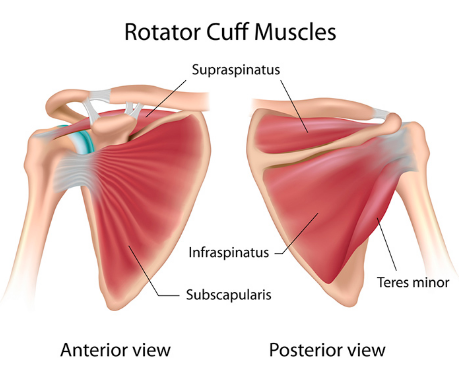- The good news (if you have a rotator cuff tear) is that most people over the age of 40 have small tears of their rotator cuff that they do not feel (asymtomatic/NO pain).
- This means that the tears are small enough that they are irrelevant, for now.
- Over time, however, these tears can become symptomic/painful (think inflammation and tendonitis) and even acculumate calcium deposits.
- My strategy is to release the scar tissue around the rotator cuff shoulder tears with:
- Active Release Techniques (so that healing/remodeling can resume)
- Shockwave Therapy for calcium deposits or deeper scar tissue
- Strength/mobility exercises.
- Class 4 laser first to help accelerate the healing and reduce pain.
Anatomy and injury
- Your rotator cuff is made up of 4 muscles and tendons in your shoulder (underneath your deltoid muscle). These muscles help to hold the head of your upper arm bone (humerous) centrally and tightly into your shoulder socket (part of shoulder blade) so that it pivots even when you are lifting your arm up overhead.
- The trade-off for massive shoulder mobility (circumduction), is a decrease in stability and potential for impingement/injury.
- If these muscles are scarred or excessively torn, impingement (typically between the head of the humerous and underneath the acromium bone) occurs.
- Impingement can lead to inflammation, tendonitis, scar tissue, pain/limitation and increased risk of (further) tearing.
Treatments are severity and phase based
Treatments may include Chiropractic (at your discretion and with your consent), Active Release Techniques (scar tissue release and mobility), Shockwave Therapy (calcification and deep scar tissue breakdown), Class 3B or 4 laser (penetrates into the rotator cuff tendons to promote healing and reduce inflammation) and stretching and rehabilitative exercises.
Often, 3-6 treatment are required for full resolution or significant healing.
